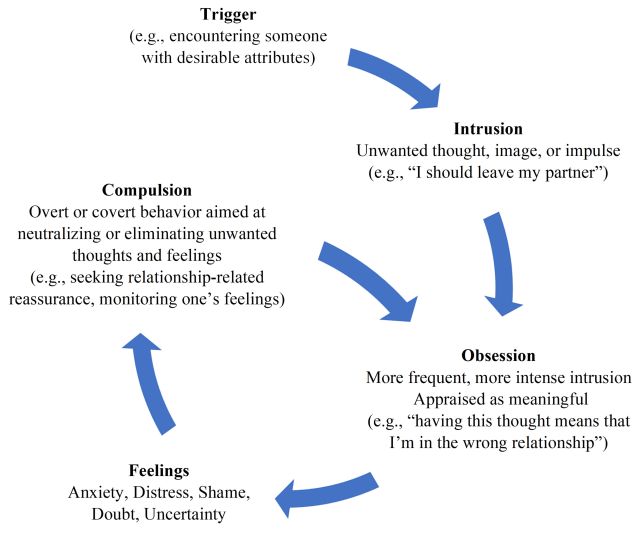OCD
A Roadmap for the Treatment of Relationship OCD
The nine components of ROCD treatment.
Updated March 22, 2024 Reviewed by Devon Frye
Key points
- ROCD is a highly debilitating condition in which one’s romantic relationship becomes the focus of obsessions.
- This article outlines the fundamental elements comprising the treatment approach for ROCD.
- Although challenging to manage, effectively treating ROCD helps foster fulfilling relationships.

In recent years, there has been a notable increase in clinical and scientific focus on relationship OCD (ROCD). As a distinctive manifestation of obsessive-compulsive disorder (OCD), ROCD centers on excessive preoccupation with one’s romantic relationships. People with ROCD experience an ongoing barrage of distressing thoughts and doubts regarding the suitability of their relationship or partner, leading to considerable emotional turmoil and interpersonal strain.
The evolving comprehension of ROCD has led to the development of specialized interventions based upon fundamental OCD treatments and tailored to address ROCD’s unique challenges. My previous articles have delved into various facets of ROCD treatment. Here, these components are gathered into a structured framework outlining the fundamental elements of the therapeutic journey.
1. Understanding the ROCD cycle.
The ROCD cycle comprises several components crucial for understanding obsessive preoccupation. These components are illustrated below.

The ROCD cycle typically initiates with a triggering event, either external (e.g., encountering an attractive person) or internal (e.g., feeling bored). This event triggers intrusive thoughts—such as "I should leave my partner"—images, or impulses. These intrusions, though unwanted and unpleasant, are natural human experiences that occur automatically and uncontrollably.
In the ROCD cycle, these natural intrusions escalate into obsessions as they appear more frequently and intensely and are regarded as meaningful (e.g., “having the thought that I should leave my partner signifies that I’m in the wrong relationship”). Obsessions are typically accompanied by distressing feelings such as anxiety, shame, doubt, and urgency. Subsequently, individuals respond to these distressing obsessions with compulsions, which are behaviors aimed at neutralizing intrusive thoughts and alleviating distress.
An initial step in coping with ROCD involves understanding this cycle and becoming aware of it in daily situations.
2. Identifying overt and covert compulsions.
Compulsions are the force maintaining the ROCD cycle. While sometimes offering temporary relief, continuous attempts to abolish one’s distressing thoughts amplify their frequency and intensity, rendering them more distressing.
Importantly, compulsive rituals fail to resolve the questions surrounding the suitability of one’s relationship or partner. In reality, such behaviors impede individuals from fully immersing themselves in their relationships and gathering the necessary information to address these ongoing queries.
When recognizing one’s compulsions, it's essential to consider both overt and covert behaviors. Common overt compulsions involve seeking reassurance from others about one’s relationship, scouring the internet for indicators of a suitable relationship, and avoiding triggering situations, such as watching romantic movies.
Covert compulsions are performed internally and mentally, posing a challenge in their identification and management. These internal behaviors, prevalent in ROCD, include continuously monitoring one’s feelings toward their partner, attempting to suppress unwanted thoughts, engaging in ongoing comparisons with others, and spending a substantial amount of time doubting the relationship.
Once compulsions have been identified, it becomes imperative to assess their inherent costs. Reflecting on how engaging in compulsions impacts one’s long-term mood, energy, and ability to remain present is crucial. Equally significant is contemplating the utility of compulsive actions by questioning whether, after repeated attempts, the person has made tangible progress in resolving lingering doubts.
3. Implementing response prevention (reducing compulsions).
Response prevention involves intentionally inhibiting compulsive reactions to one’s distressing thoughts and feelings. Response prevention is guided by understanding the ineffectiveness of compulsions as a sustainable solution for addressing one’s relationship-related doubts; instead of reducing distress, they only strengthen ROCD.
When implementing response prevention, it is essential to distinguish the automatic from the more controllable parts of the ROCD cycle. While experiencing intrusions and distressing feelings is mostly automatic, individuals can assert control over engaging in compulsions as a response to these automatic elements.
Acknowledging that unwanted intrusions will pop up no matter what and that compulsions harm rather than help can be difficult. However, in accepting this, people can start focusing their energy and attention on the parts they can ascertain control over (i.e., their compulsive reactions).
For example, imagine the intrusive thought “I might be in the wrong relationship” spontaneously arising, along with distressing feelings. Although such upsetting thoughts are often beyond immediate control, they do not require engaging in laborious compulsions, like seeking reassurance from friends, monitoring emotions towards the partner, or engaging in prolonged deliberations about the validity of the relationship.
4. Practicing tools to support response prevention.
Response prevention is often easier said than done. When refraining from compulsive behaviors, people may find themselves lacking alternative methods to manage persistent thoughts and distressing emotions. Hence, it is imperative to practice supplementary tools to support this work. Several techniques utilized in treatment include:
- Attention training: This involves redirecting attentional focus towards the external environment despite the inclination to obsess over thoughts or feelings. Gradually, individuals build a “focus-shifting muscle,” enabling them not to suppress but to disengage from their thoughts and feelings, redirect their attention, and become present in the current moment.
- Allocating designated time for deliberations: Designating specific periods for relationship-related contemplations and postponing preoccupation with such questions to those scheduled times helps individuals refine their approach to inner experiences. This practice empowers individuals to choose when and how they address their thoughts and feelings, rather than being “bossed around” by them and feeling obligated to react to them whenever they arise.
- Mindfulness: Through mindfulness practice, individuals develop the ability to observe and acknowledge their inner experiences—thoughts, feelings, and physical sensations—without getting involved or attempting to alter them.
- Postponing compulsions: When complete abstention from compulsions appears too challenging, individuals can adopt the strategy of delaying engagement. Creating a brief time gap between the urge to engage in a compulsion and the actual execution strengthens one’s control over mental processes. Over time, this temporal gap can be progressively extended, fostering increased self-regulation.
5. Engaging in exposure and response prevention (ERP).
After becoming familiar with response prevention, practicing ERP takes recovery a step further. In ERP, individuals purposefully expose themselves to their fears and triggers, allowing the experience of distressing emotions while refraining from compulsive behaviors. Through this deliberate confrontation in which one chooses the time, place, nature, and duration of each exposure, individuals become significantly empowered in their ability and self-confidence to manage their distress.
Exposures in ROCD can include in-vivo scenarios involving real-life triggering situations. For example, viewing unflattering images of one’s partner can serve as exposure for individuals fixated on their partner’s physical appearance, while watching romantic movies can serve as exposure for those obsessed with relationship doubts.
Exposures can also be conducted through imaginative means, such as writing a narrative detailing feared outcomes (e.g., being stuck in the wrong relationship), and rereading it during designated periods.
The content and form of exposure should align with individuals’ specific fears and obsessions. As ERP can be challenging, it is often built incrementally, starting with less challenging exposures and gradually progressing to more difficult ones. Crucially, during ERP practice, it is imperative to prioritize response prevention and resist the temptation to engage in compulsions.
6. Acknowledging and addressing core fears.
While people with ROCD struggle with anxiety-inducing questions concerning their relationship and partner’s suitability, these surface fears are often manifestations of a deeper, underlying core fear. For instance, becoming trapped and alone in an endless cycle of suffering, perhaps by making erroneous relationship decisions, is a common ROCD fear.
Facilitating the recognition and articulation of these core fears is an important step in ROCD treatment. This process enables individuals to gain insight into the origins of their fears, the underlying motivations behind their compulsive behaviors, and a deeper understanding of themselves.
Upon identifying their core fear, integrating it into ERP work becomes imperative. This may involve envisioning the manifestation of the core fear or crafting a narrative depicting its realization. By incorporating exposure to their core fear into ERP sessions, individuals deepen their resilience to confronting their deepest anxieties and the associated compulsions, thereby fostering enhanced coping mechanisms.
7. Investing in relationships.
People with ROCD may find it challenging to invest in their relationship when plagued by uncertainty. They often fear that investment might give their partner the wrong impression about their readiness to commit. However, paradoxically, withholding investment in the relationship diminishes its appeal, reinforcing doubts about its suitability and stability.
Relationship growth and fulfillment require a willingness to invest emotionally and mentally. By actively engaging in the relationship and reducing reliance on compulsive behaviors, individuals can gradually witness and experience the full potential of their partnerships. This proactive approach enables them to more clearly evaluate the relationship.
Integral to the treatment of ROCD is dedicating time to proactively focus on being present in one’s relationship without resorting to compulsions when faced with distressing thoughts and emotions regarding relationship doubts.
8. Recognizing and challenging extreme love beliefs.
ROCD sufferers often hold onto excessive beliefs about the ideal nature of relationships. These beliefs dictate how one should feel (e.g., constantly in love, devoid of negative emotions), think (e.g., free of doubts or critical thoughts), and act (e.g., never looking at others) when in the “right” relationship.
Clutching onto these extreme love beliefs reinforces the perception of one’s thoughts and emotions as abnormal, fostering obsessive tendencies. For example, engaging in questions such as “What’s wrong with me if I’m feeling bored while with my partner?” or “Can this be the right relationship if I’m experiencing doubt?” actively maintains the ROCD cycle.
The initial step in addressing extreme love beliefs involves acknowledging their learned nature rather than considering them absolute truths. These beliefs often stem from early exposure to relationship models, familial influences, and societal portrayals of romance prevalent in Western culture.
Subsequently, individuals should assess the costs associated with closely adhering to these beliefs, such as experiencing shame regarding their thoughts and feelings or engaging in prolonged deliberations about their relationships. Exploring alternative beliefs, such as recognizing that loving relationships encompass a spectrum of emotions, can offer valuable insights into recalibrating one’s perspective on relationships and changing their experience of the relationship.
9. Partner disclosure.
Many individuals with ROCD feel compelled to hide their doubts and uncertainties about their relationships from their partners, viewing them as abnormal or inappropriate. Alternatively, some may fear the repercussions of disclosing their distressing thoughts.
However, concealing one’s doubts only amplifies their significance, intensifying anxiety each time they resurface. Prolonged concealment fosters feelings of shame and guilt, both for having doubtful thoughts and for withholding them, further isolating the individual and distancing them from their partner. Sharing their experience can alleviate this burden, lessening feelings of isolation and emotional strain.
Navigating the disclosure of ROCD to a partner requires sensitivity. In the treatment of ROCD, it is advisable to involve the partner when the individual feels ready, in a manner that is suitable to both parties.
Beginning by providing the partner with a foundational understanding of OCD as a condition characterized by distressing thoughts accompanied by compulsions can facilitate the conversation. Then, one could describe the nature of their OCD, in which their distressing thoughts are focused on relationship-related issues.
When disclosing ROCD to a partner, it is advisable to avoid delving into the specific content of one’s intrusive thoughts. Instead, engaging in a broader conversation about relationship questions, their distressing impact on ROCD sufferers, and the way they escalate into compulsions is recommended. Such conversations are often best facilitated in a therapeutic setting where the partner can join the discussion.
An additional objective of disclosing ROCD to a partner is to foster a collaborative alliance. Partners can be guided to empathetically acknowledge the distress experienced by the individual with ROCD while not participating in their compulsions.
For example, partners may answer repetitive questions like “Do you genuinely love me?” because they think doing so is helpful. However, repeatedly answering such questions facilitates the individual’s engagement in compulsions. Thus, refraining from answering while showing empathy for the individual’s distress will help them effectively practice response prevention.
Considerate disclosure of one’s ROCD can transform the partner into a supportive ally, aiding in alleviating the burden of concealment and contributing to effective coping with ROCD.
Conclusion
Coping with ROCD can be challenging and confusing. Effective treatment provided by an OCD specialist offers guidance and support through the outlined steps, empowering clients to become present and engage more fully in their relationships while overcoming the constraints of ROCD. This process facilitates the development of meaningful and fulfilling relationships.
To learn more about Relationship OCD, click here.




